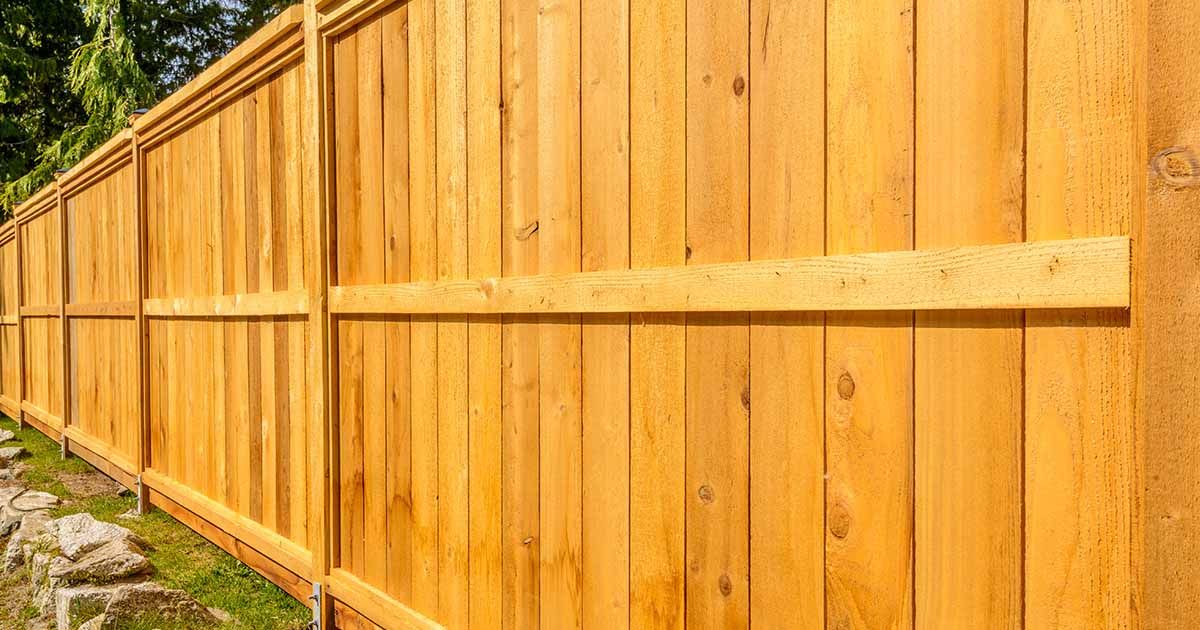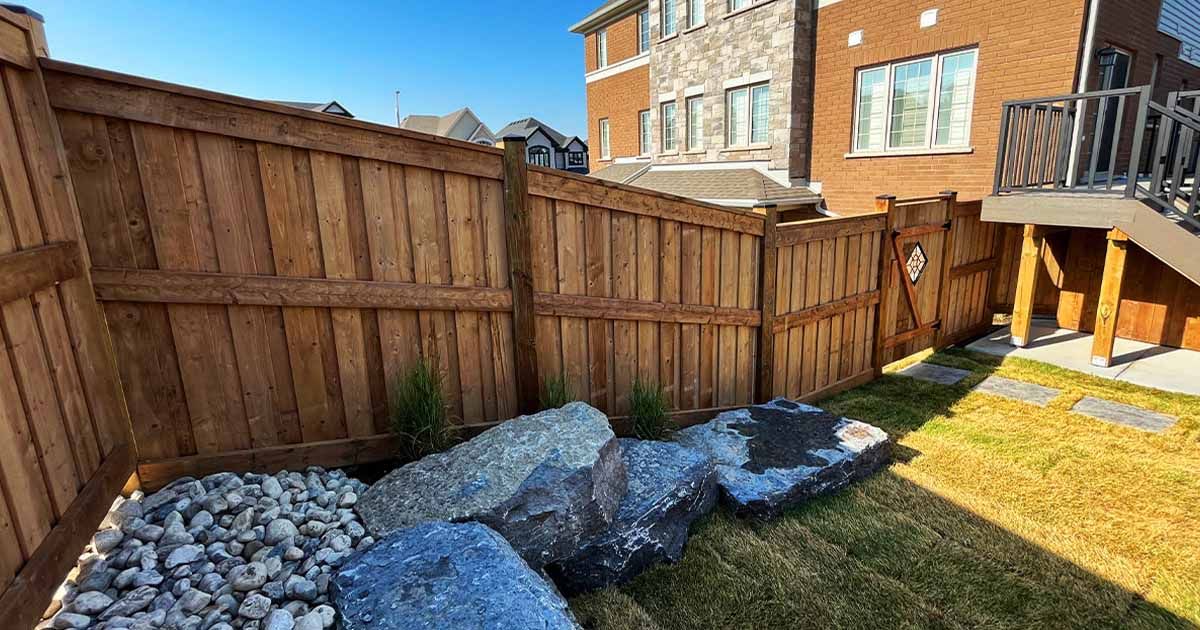Resolut Blog
The Science of Fence Foundations: How to Ensure Stability
When it comes to installing a fence on your property, you might think it's a straightforward task —just put up some posts and attach some panels, right?

However, homeowners often overlook the critical role that fence foundations play in ensuring the stability and longevity of their fences. The foundation is the hidden hero that supports your fence and keeps it standing strong against the elements and everyday wear and tear.
In this blog post, we'll dig deep into the science of fence foundations and shed light on why they are so essential.
At Resolut Construction, we specialize in all things fencing. Recognized in the Waterloo Region and beyond for quality and timeless workmanship, we have been building premium residential and commercial deck and fence projects for the past 30 years. If you’re planning to install a new fence in the near future or would like your existing one looked at, don’t hesitate to reach out. We will gladly come to assist with your project!
Let’s begin!
The Importance of a Strong Fence Foundation
A stable fence foundation is important because it serves as the fundamental support system for your fence structure. Without a solid foundation, your fence is susceptible to leaning, tilting, or even collapsing under the weight of environmental factors like wind, soil erosion, and moisture. This instability compromises your property’s aesthetic appeal and jeopardizes its security and privacy.
Benefits of a Stable Fence
Enhances the overall appearance and value of your property: A well-maintained and stable fence adds curb appeal and can increase property resale value.
Ensures privacy: It keeps prying eyes away from your outdoor space, offering you a sense of seclusion.
Provides security: A secure fence protects your property from potential intruders, wild animals, or even playful pets. This gives you a sense of safety and peace of mind.
Requires less maintenance and repair: Over its lifespan, a stable fence needs fewer repairs and less maintenance, ultimately saving you both time and money in the long run.
Types of Fence Foundations
Concrete Footings
Concrete footings involve pouring concrete into holes dug in the ground to create a stable and solid foundation for fence posts. They are highly durable and provide excellent stability, especially in areas with varying weather conditions or heavy wind.
At Resolut Construction, we prioritize the construction of sturdy concrete footings and excel in tailoring foundation solutions to each unique situation. Our commitment to both robust foundations and customized approaches ensures long-lasting stability for any fencing project. Give us a call or send us an email and let’s get started on your next fencing project.
Post Anchors
Post anchors are metal brackets or supports that secure the fence posts to an existing structure, such as a concrete slab or a deck. They are a convenient option for attaching fence posts without the need for deep holes or concrete work.
Soil Compaction
Soil compaction involves densely packing the soil around fence posts to create a stable base. This method is cost-effective and can work well in areas with favourable soil conditions, such as areas with well-draining and stable soils.
When to Use Each Type of Fence Foundation
The choice of fence foundation type should depend on several factors, including the fence's purpose, local climate, soil conditions, and your budget. Here's a brief guideline on when to use each type:
Concrete footings: Ideal for tall or heavy fences, areas with extreme weather conditions, and locations with unstable soils prone to shifting or settling.
Post anchors: Suitable for attaching fences to existing structures like decks or concrete slabs, providing a sturdy and secure attachment point.
Soil compaction: A cost-effective option for shorter fences in areas with stable and well-draining soils, where frost heave is not a significant concern.
Factors Affecting Fence Stability

Soil Type and Quality
Soil type plays a crucial role in fence stability, as different soils have varying levels of compaction and stability.
Sandy soils are generally less stable and may require more substantial foundations to prevent leaning or shifting.
Clay soils can expand and contract with moisture changes, potentially causing fence posts to heave or settle.
Loamy soils, which are a mix of sand, silt, and clay, often offer good stability, but the specific characteristics may vary by region.
It's essential to assess your soil's composition and consider soil tests when planning your fence foundation.
Weather Conditions
Weather conditions, including wind, rain, and temperature fluctuations, can impact fence stability.
High winds can exert a significant lateral force on a fence, making secure foundations and proper anchoring crucial to prevent tipping or damage.
Heavy rainfall and poor drainage can soften the soil, leading to post settling or heaving, especially in clayey soils.
Frost heave can occur in colder climates when moisture in the soil freezes and expands, potentially pushing fence posts out of position.
Hot and dry conditions may cause the ground to contract, affecting fence stability.
Choosing the right foundation type and materials that can withstand your local weather conditions is essential for long-lasting stability.
Fence Material and Design
The choice of fence material and design also influences stability.
Heavier materials like wood or metal may require stronger foundations to support their weight.
Fence designs with wider panels or larger surface areas can catch more wind, making proper anchoring even more critical.
Solid privacy fences may experience more wind resistance than open or decorative designs.
Consider the specific characteristics of your chosen fence material and design when planning your foundation to ensure it can adequately support the fence's weight and withstand environmental forces.
Steps to Ensure Fence Stability
Step 1: Prepare the Ground
Conduct soil tests to assess the composition and quality of the ground where you plan to install your fence. Soil testing helps determine whether the soil is stable and can provide insights into its drainage properties, compaction, and potential for frost heave. Based on the test results, you can make informed decisions regarding the type of foundation needed.
Clear the area of any debris, rocks, or vegetation that could hinder the installation process.
Excavate the ground to the appropriate depth, taking into account the recommended foundation type and the frost line in your area. Proper excavation ensures a level and stable base for your fence.
Step 2: Choose the Right Foundation Type
Based on the soil analysis, local climate conditions, and your specific project needs, select the most suitable foundation type (e.g., concrete footings, post anchors, or soil compaction) as discussed earlier in the blog post.
Step 3: Properly Install the Fence Posts
Ensure that fence posts are installed at the correct depth, which typically goes below the frost line to prevent frost heave issues.
Maintain consistent spacing between posts to support the overall structural integrity of the fence.
Follow manufacturer guidelines or local building codes for specific depth and spacing requirements.
Depending on the chosen foundation type, employ appropriate anchoring techniques.
For concrete footings, ensure that the concrete is mixed and poured correctly around the posts.
If using post anchors, secure them firmly to the existing structure or concrete slab.
When relying on soil compaction, compact the soil around the posts thoroughly to create a stable base.
Step 4: Weatherproofing and Maintenance
If your fence includes wooden posts, treat them with a wood preservative or sealant to protect against moisture, rot, and decay.
Regularly inspect and reapply treatments as needed to maintain the wood's integrity.
If your fence includes metal components, such as brackets or fasteners, use rust-resistant materials.
Apply anti-corrosion coatings or paint to metal parts to prevent rust and extend their lifespan.
Inspect metal components periodically for signs of rust and address any issues promptly.
Professional vs. DIY Installation
In deciding between professional or DIY fence installation, hiring professionals provides the advantage of expertise, precision, and adherence to regulations, ensuring proper fence stability and potentially offering warranties for added peace of mind. However, this option can be costlier and dependent on scheduling.

On the other hand, a DIY approach allows for cost savings and customization but demands extensive research, planning, and effort to master soil analysis, foundation types, and installation techniques, with potential setbacks and additional expenses if not executed correctly. Safety precautions and equipment are crucial for DIY projects, especially when working with materials and excavation.
At Resolut Construction, we specialize in all things fencing. Recognized in the Waterloo Region and beyond for quality and timeless workmanship, we have been building premium residential and commercial deck and fence projects for the past 30 years. If you’re planning to install a new fence in the near future or would like your existing one looked at, don’t hesitate to reach out. We will gladly come to assist with your project!
Contributors
Latest Posts
Show All Recent Posts
Archive
-
2025
-
2024
-
December
-
November
-
October
-
August
-
July
-
June
-
May
-
April
-
March
-
February
-
January
-
-
2023
-
December
-
November
-
October
-
September
-
August
-
July
-
June
-
May
-
April
- Kitchener Waterloo Residential Fence: Buying Guide
- Incorporating Fencing into your Landscaping Design
- Choose a Chain Link Fence Installer You Can Trust
- Prepare Your Backyard for Summer: Outdoor Organization Ideas
- 7 Essential Tips For Your Kitchener Waterloo Fencing Project
- A Comprehensive Guide For Making Your Fence Pet-Friendly
-
March
-

